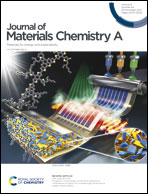Progress in morphology control from fullerene to nonfullerene acceptors for scalable high-performance organic photovoltaics†
Abstract
With the development of nonfullerene acceptors (NFAs), the efficiency of organic photovoltaics (OPVs) has been remarkably improved and exceeded 18%. The morphology of bulk heterojunction (BHJ) films significantly affects all individual steps of exciton generation and charge separation and transport. Although many solution processing techniques developed from fullerene-based systems have been effectively utilized for morphology control of NFA-based BHJs, the optimization process is still complicated due to diverse chemical structures of donor and NFA materials. In addition, it is important to develop materials and processing techniques for reliable transfer of the BHJ morphology realized in small-areas to large-areas. This article reviews mechanisms of morphology evolution of the BHJ film and recent research progress for control of NFA-based BHJs; this includes studies of structure–property relationship of organic materials and processing techniques which have been practically employed for morphology optimization of the NFA blends, such as uses of ternary compositions and solvent additives and post treatments of the BHJ film. Finally, we survey coating techniques for producing scalable BHJs and provide perspectives to realize high-performance OPV devices for practical industrial applications. This review can serve as a guide to resolve the morphological issues for new materials to achieve higher efficiency NFA-based OPVs.



 Please wait while we load your content...
Please wait while we load your content...